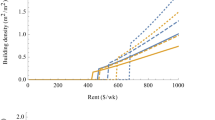Conclusion
A modified Wicksell model has been used to explain optimal timing decisions concerning the development of land from a lower to a higher urban use. The analysis has shown that, within the context of the assumptions, the optimal date for development or redevelopment of urban land depends on (1) the discount rate applying in the real estate market, (2) the property tax rate, (3) the earnings in any interim use, and (4) the way in which the higest and best use of the land is expected to change in the future. The analysis has also shown that the mere presence of rises in the value of land awaiting development to a higher use should not automatically be interpreted as speculative gains; rather, an increase in the value of such land is inherent in the process of capitalization of future income. More properly, only "windfall" changes in the value of land, which arise because of imperfectly foreseen evens that affect future development potential, should be considered speculative gains.
Similar content being viewed by others
References
Richard T. Ely and George S. Wehrwein,Land Economics (New York: The Macmillan Company, 1940), pp. 148–150.
The marginal social product of land may differ considerably from the private marginal product if there are externalities associated with its use. To some extent these externalities are taken into account by zoning and other planning regulations. To the extent that these externalities are not accounted for by the planning framework, the optimal timing conditions presented here will differ from socially optimal conditions, for the present analysis is concerned with optimal timing from the point of view of the investor.
Alfred Marshall called this point the “margin of building”.Principles of Economics (8th ed.; London: Macmillan Ltd., 1961), p. 371.
Alternatively stated, the profit maximizing outlay on improvements occurs where the marginal rate of return on capital investment in construction equals the interest rate.
This description of the static case follows, for instance, that of Ralph Turvey,The Economics of Real Property, (London: George Allen & Unwin Ltd., 1957).
Some buildings are even built with the intention of being potentially permanent. As an example, when the Singer Building in New York, once the tallest building in the world and still the tallest building ever to be demolished, was torn down recently, it was reported that the architect who designed the building stated that it was “designed to last as long as the pyramids.” And as one example of the way that buildings face obsolescence in response to changed consumer tastes, the Singer Building had a central vacuum system with outlets in each executive office for cleaning silk hats.
Knut Wicksell,Lectures on Political Economy, E. Classen, trans. (London: Routledge and Kegan Paul Ltd., 1934), I, pp. 178–181.V(T) as defined here is analogous to the lumber content of a growing tree whose optimal date of harvest is to be determined.
Equations (1) and (2) show that this optimal data of development maximizes the present value of the land for allt<T.
There is also the possibility of nonunique solutions, in which case the global maximum is the relevant one.
The result is, of course, expected. Since appreciation in value is the only return from holding vacant land, the rate of appreciation should equal the rate of return on comparable alternative investments.
This assumes that the level of property-related government services would be unchanged even in the absence of real estate taxes. If, however, the tax revenues were used to finance services of benefit to the property taxed, the value of the land might not decline at all.
It will be assumed that the development value of the land,V(T), is independent of the interim use to which the land is put. Any cost of removing interim improvements is deducted fromA(T,T).
Note that this doesnot say that redevelopment of improved property to a higher urban use should be undertaken as soon as the development value of the site, net of clearance costs, exceeds the value of the existing improved property, as is sometimes stated.
A recent study found that between 1954 and 1962, vacant land awaiting urbanization in one area of Philadelphia appreciated at a rate of 9.7 per cent per year in real terms when several factors (location, state of land, zoning) were held constant. Real estate taxes reduced this return to 7.7 per cent per year, which the authors felt represented a normal rate of return considering the risk, illiquidity, and transaction costs involved in land investment. F. Gerard Adams, Grace Milgram, Edward W. Green, and Christine Mansfield, “Undeveloped Land Prices During Urbanization: A Micro-Empirical Study Over Time,”Review of Economics and Statistics, L, No. 2 (May, 1968), pp. 248–258.
Theoretically, with perfect certainty and an infinite time horizon, an investor would plan asequence of developments for the site. Practically, the typical building lifetime is probably so long in relation to the feasible time horizon that investors would not plan beyond the lifetime of the next improvement.
The earlier mentioned externalities associated with land use are a different sort of imperfection which would lead to nonoptimal allocation even in the absence of other market imperfections.
Author information
Authors and Affiliations
Rights and permissions
About this article
Cite this article
Shoup, D.C. The optimal timing of urban land development. Papers of the Regional Science Association 25, 33–44 (1970). https://doi.org/10.1007/BF01935815
Issue Date:
DOI: https://doi.org/10.1007/BF01935815




